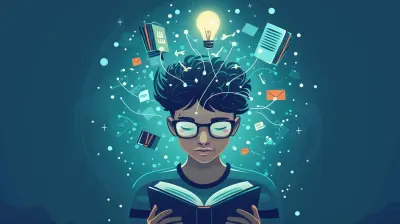Effective Ways to Teach Inferring Skills
27 August 2025
Inferring is one of the most essential critical thinking skills students need to develop. It allows them to read between the lines, make logical guesses, and understand deeper meanings beyond what is explicitly stated. Whether it's in reading comprehension, problem-solving, or real-world decision-making, inferring plays a crucial role in shaping independent thinkers.
But let’s be honest—teaching students how to infer isn’t always easy. Some kids naturally pick up on clues and hints, while others struggle to make connections. So, how do we build strong inferring skills in all learners?
In this guide, we’ll explore practical, engaging, and effective ways to teach inferring skills in any classroom. 
What Is Inferring?
Before diving into strategies, let’s break down what inferring actually means.Inferring is the process of using clues from a text, situation, or conversation to arrive at a conclusion that isn't directly stated. It's like being a detective—piecing together evidence to uncover hidden meanings.
For example, if a story says, "John came inside soaked, stomping his feet and mumbling under his breath," we can infer that:
- It was raining outside.
- John is frustrated or upset.
Students must learn to use both prior knowledge and textual evidence to make inferences effectively. 
Why Are Inferring Skills Important?
Inferring isn’t just about reading comprehension; it’s an essential life skill. Here’s why:✔ Enhances Critical Thinking – Encourages students to analyze information rather than just accepting it at face value.
✔ Boosts Reading Comprehension – Helps students understand the deeper meaning behind texts, characters, and themes.
✔ Improves Communication – Allows students to pick up on non-verbal cues and implied meanings in conversations.
✔ Encourages Independent Learning – Students learn to ask questions, seek answers, and develop their own interpretations.
Without the ability to infer, students may struggle to connect information, affecting their overall learning experience. 
Effective Ways to Teach Inferring Skills
Now, let's explore some creative and effective strategies to help students develop strong inferring skills.1. Use Picture Prompts
Visual images are a fantastic way to introduce inference. Display a picture and ask students:- What do you think is happening?
- How do you know?
- What clues helped you figure that out?
For example, show an image of a child holding a broken toy with a sad expression. Students can infer that the child is upset because their toy is broken.
This exercise helps students practice looking for visual clues before moving on to texts.
2. Read Aloud and Think Aloud
One of the best ways to teach inference is by modeling it. Choose a book and read a passage aloud. Then, pause and verbalize your thinking process:"Hmm, the author didn’t say the character is scared, but they described her heart pounding and hands shaking. That makes me think she’s nervous or afraid."
When students hear you making inferences, they begin to see the thought process behind it.
3. Teach Students to Use Text Clues + Background Knowledge
Inferring is a mix of text clues and prior knowledge. Teach students this simple formula:Text Clues + What I Already Know = My Inference
For example, if a story says, "Liam shivered and wrapped his arms around himself," students can use text clues (shivering) and background knowledge (shivering happens when it’s cold) to infer that Liam is cold.
Encourage students to apply this formula while reading.
4. Play "What’s in the Bag?"
This fun activity helps students practice making inferences with real objects. Here’s how to play:1. Put an object in a bag.
2. Give students clues about the object without revealing it (e.g., "It's something you use in the kitchen. It's round and helps you flip food.").
3. Have students infer what’s inside based on the clues.
This hands-on approach makes inferring interactive and engaging!
5. Use Wordless Picture Books
Wordless picture books rely solely on illustrations, making them perfect for teaching inference. Books like Tuesday by David Wiesner or Flotsam challenge students to analyze images and create their own interpretations.Ask questions like:
- What do you think happened before this scene?
- How do you know?
- What might happen next?
This encourages students to infer based on visual storytelling.
6. Create Inference Passages with Missing Information
Give students short passages with missing details and ask them to fill in the gaps using inference.Example:
"Emma couldn’t stop sneezing. She grabbed another tissue and groaned. Her mom handed her a cup of tea and said, ‘You should rest today.’"
Ask students:
- What can you infer about Emma?
- How do you know?
Activities like this train students to seek out clues and draw logical conclusions.
7. Play "Two Facts and an Inference"
Turn inference into a fun classroom game!1. Write two factual statements and one inference on the board.
2. Have students identify which one is an inference.
Example:
- Sarah stayed up past midnight.
- She had a math test in the morning.
- She must have been studying all night. (Inference)
This game helps students distinguish between facts and inferences.
8. Use Real-Life Scenarios
Inference isn’t just for reading—it’s a real-life skill! Help students practice by discussing everyday scenarios:- If you see someone running with an umbrella, what might you infer?
- If your friend is quiet and avoiding eye contact, what can you infer?
These discussions encourage students to apply inference in their daily lives.
9. Encourage "Why Did They Do That?" Discussions
Characters’ actions often reveal hidden meanings. After reading a story, ask:- Why did the character act this way?
- What emotions or motivations might have influenced their actions?
- What evidence from the text supports this?
By examining character behavior, students develop deeper comprehension skills.
10. Use Short Videos and Commercials
Short films and commercials are great for inference. Play a video without sound and ask students:- What’s happening?
- How do you know?
- What clues helped you infer that?
Silent short films, like Pixar’s The Present or For the Birds, are excellent choices. 
Final Thoughts
Teaching inferring skills doesn't have to be complicated. The key is to make it interactive, engaging, and relevant to students' lives. Whether through picture prompts, fun games, or real-world scenarios, helping students develop their inference abilities will set them up for success in reading, problem-solving, and critical thinking.So, next time you're teaching inference, think like a detective—observe, analyze, and piece together the clues. Your students will be master inferrers in no time!
all images in this post were generated using AI tools
Category:
Reading ComprehensionAuthor:

Monica O`Neal
Discussion
rate this article
1 comments
Remington Bishop
Great insights! Inferring skills truly empower students' critical thinking.
September 1, 2025 at 2:56 AM

Monica O`Neal
Thank you! I'm glad you found the insights valuable; inferring skills are indeed crucial for enhancing critical thinking.


